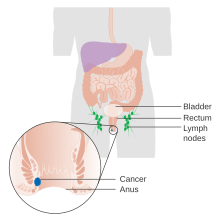| Anal cancer | |
|---|---|
 | |
| Diagram showing stage 1 anal cancer | |
| Specialty | Oncology |
| Symptoms | Anal bleeding or lump[1] |
| Usual onset | Age over 45 years[2] |
| Types | Squamous cell carcinoma, adenocarcinoma, small cell carcinoma, melanoma[3] |
| Risk factors | Human papillomavirus (HPV), HIV/AIDS, receptive anal sex, smoking, many sexual partners[1][4] |
| Diagnostic method | Physical examination, tissue biopsy[1] |
| Differential diagnosis | Anal warts, hemorrhoids, anal fissure[5] |
| Prevention | HPV vaccination, avoiding risk factors[6] |
| Treatment | Radiation therapy, chemotherapy, surgery[1] |
| Prognosis | Five year survival ~68% (US 2015)[2] |
| Frequency | 8,300 (US 2019)[2] |
| Deaths | 1,280 (US 2019)[2] |
Anal cancer is a cancer which arises from the anus, the distal opening of the gastrointestinal tract.[1] Symptoms may include bleeding from the anus or a lump near the anus.[1] Other symptoms may include pain, itchiness, or discharge from the anus.[1] A change in bowel movements may also occur.[1]
Risk factors include human papillomavirus (HPV), HIV/AIDS, receptive anal sex,[4] smoking, and many sexual partners.[1] Anal cancer is typically a squamous cell carcinoma.[3] Other types include adenocarcinoma, small cell carcinoma, and melanoma.[3] Diagnosis is suspected based on physical examination and confirmed by tissue biopsy.[1]
Prevention includes avoiding risk factors and HPV vaccination.[6] Standard treatment may include radiation therapy, chemotherapy, and surgery.[1] About 8,300 people are diagnosed a year in the United States, representing about 0.5% of new cancers.[2] Onset is typically after the age of 45.[2] Women are affected more often than men.[2] The number of cases has increased since the 1990s.[3] The five-year survival rate in the United States is 68%.[2]
- ^ a b c d e f g h i j k "Anal Cancer Treatment". National Cancer Institute. 2018. Retrieved 30 May 2019.
- ^ a b c d e f g h "Cancer of the Anus, Anal Canal, and Anorectum—Cancer Stat Facts". SEER. Retrieved 30 May 2019.
- ^ a b c d Nelson, VM; Benson AB, 3rd (January 2017). "Epidemiology of Anal Canal Cancer". Surgical Oncology Clinics of North America. 26 (1): 9–15. doi:10.1016/j.soc.2016.07.001. PMID 27889039.
{{cite journal}}: CS1 maint: numeric names: authors list (link) - ^ a b Daling, Janet; et al. (1987). "Sexual Practices, Sexually Transmitted Diseases, and the Incidence of Anal Cancer". The New England Journal of Medicine. 317 (16): 973–977. doi:10.1056/NEJM198710153171601. PMID 2821396.
- ^ Garden, O. James; Bradbury, Andrew W.; Forsythe, John L. R.; Parks, Rowan W. (2012). Principles and Practice of Surgery E-Book. Elsevier Health Sciences. p. 272. ISBN 9780702051166.
- ^ a b "Anal Cancer Prevention". National Cancer Institute. 14 February 2014. Retrieved 30 May 2019.